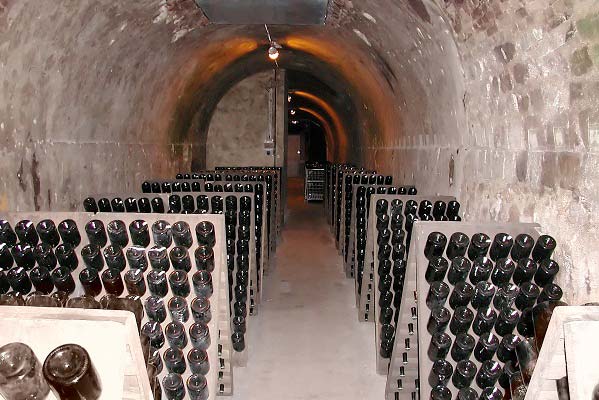Sparkling wine is a wine with significant levels of carbon dioxide. There are several ways to make sparkling wine, but the finest is the traditional method-methode traditionnelle. Also known as ;Metodo Classico in Italy, and the Traditional Method in the USA, Chile, and Australia.
 The wine is fermented once on the barrel and then undergoes a second fermentation in the bottle after the addition of yeast, nutrients for the yeast, and sugar, or tirage. The second fermentation results in a natural sparkling wine. Yeast precipitate (lees) must then be removed. This begins with riddling (remuage in French) which means that the bottles are turned with the neck downwards and lightly shaken to move the lees to the neck of the bottle. This is done in small steps where the bottle orientation gradually changes. Finally the inverted bottle necks are cooled so that the precipitation freezes to a small block of ice, the bottles are turned upright and the temporary closure (normally a crown cap) is opened so that the precipitate is pushed out by the pressure in the bottle. Then the bottle is filled to replace the missing volume, and fitted with a plain Champagne cork and halter. The process to remove lees is called disgorging.(source:wikipedia)
The wine is fermented once on the barrel and then undergoes a second fermentation in the bottle after the addition of yeast, nutrients for the yeast, and sugar, or tirage. The second fermentation results in a natural sparkling wine. Yeast precipitate (lees) must then be removed. This begins with riddling (remuage in French) which means that the bottles are turned with the neck downwards and lightly shaken to move the lees to the neck of the bottle. This is done in small steps where the bottle orientation gradually changes. Finally the inverted bottle necks are cooled so that the precipitation freezes to a small block of ice, the bottles are turned upright and the temporary closure (normally a crown cap) is opened so that the precipitate is pushed out by the pressure in the bottle. Then the bottle is filled to replace the missing volume, and fitted with a plain Champagne cork and halter. The process to remove lees is called disgorging.(source:wikipedia)
The pinnacle of all sparkling wine regions is Champagne, in northern Frane, but France's Loire Valley, northern Italy, northeastern Spain, and N. California all make exceptional examples as do many other places with cool climates and mineral-rich soils.
Champagne Grapes: French Champagne vintners are permitted to use only three grape varieties: Chardonnay, Pinot Noir, and Pinot Meunier. Blanc de Blancs are make from 100% Chardonnay, Blanc de Noirs are sparkling whites produced with red grapes Pinot Noir and or Pinot Meunier. Roses are created by blending a bit of red wine into white sparkling wine by leaving the grape skins in the pressed juice for a short time to bleed in some color.
The carbon dioxide may result from natural fermentation, either in a bottle, as with the méthode champenoise, in a large tank designed to withstand the pressures involved (as in the Charmat process, or as a result of carbon dioxide injection). Sparkling wine is usually white or rosé but there are many examples of red sparkling wines such as Italian Brachetto and Australian sparkling Shiraz. The sweetness of sparkling wine can range from very dry "brut" styles to sweeter "doux" varieties.
Many sparkling wines are produced across the globe, such as Espumante in Portugal, Cava in Spain, Franciacorta, Trento, Oltrepò Pavese Metodo Classico, and Asti in Italy(the generic Italian term for sparkling wine being spumante) and Cap Classique in South Africa. Most countries reserve the word Champagne for a specific type from the Champagne region of France. The French terms "Mousseux" or "Crémant" are used to refer to sparkling wine not made in the Champagne region. German and Austrian sparkling wines are called Sekt. The United States is a significant producer of sparkling wine with producers in numerous states. Recently the United Kingdom, which produced some of the earliest examples of sparkling wine, has started producing sparkling wines again.(Source: Wikipedia, Food and Wine's Wine Guide 2012)
